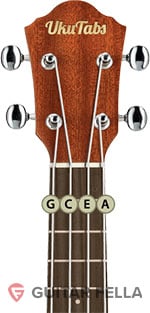

So you can technically use any guitar tab and play it on your guitalele - the song will sound the same, just in a higher key.Ħ-String Ukulele - GCCEAA (usually the two Cs are tuned an octave apart, while the two As are in unison) Standard ukuleles are basically guitars that are tuned 2 1/2 steps up with the two bass strings removed, so a guitalele is the same thing (except it still has the two bass strings). The usual tuning for guitaleles is just as you got it (ADGCEA) and it is played using guitar chord shapes. Thank you so much for being a part of the Underground! From the sound of it, it seems like you bought a guitar-ukulele hybrid (often called a "guitalele"), which is different from a 6-string ukulele where two of the courses are doubled up (see image above). Would you suggest removing 2 strings or something else? I am a brand new student and would like to be able to apply what I learn from your course to both of the ukes. I bought it so I could have a uke in the 2 places I frequent without being concerned with damaging it during travel. It looks more like a small guitar in its stringing. Also the fret board does not look the same as the pictured fret board in the forum, with the C's and A's so close together. Nothing I've seen so far addresses this tuning. It’s as if you put a capo on the 5th fret of a guitar.I bought a used 6 string uke that came tuned as ADGCEA. (Unless you wear a cape when you play.) GuitaleleĪn ukulele-sized guitar that is tuned to ADGCEA. I think the “super” thing is probably just a marketing ploy.

This is due mainly to the resonating surface each ukulele has.

However, play the same song on a soprano ukulele, concert ukulele, tenor ukulele, and then a baritone ukulele and you’d find a much larger range of sounds. If you have Jake Shimabukuro play the same song on four different tenor ukuleles of similar quality, you would notice that they sound different, but not in a huge way.

The Effect of Size on Soundīesides the obvious physical differences, sound tops off the list of what makes the ukulele sizes unique. Every luthier uses different dimensions for each of their ukulele sizes. The scale, length, and fret specs presented below are just averages. A shorter scale forces the overtones into less space for a thick, fuzzy tone. A long scale gives the harmonics and overtones more room to ring and thus has a bright, chime-y sound. The tension and scale length also affect the tone of the ukulele. A set of soprano strings are chosen for those tensions and measurements.īut put those same strings on a 17″ tenor scale and try tuning it to GCEA and you’ll find that the tuning gets pretty tight before you reach concert pitch. It has a scale length of 13-14″ tuned to GCEA. The length of the scale affects the spacing of the frets, but it also changes how the strings feel to play and sound.Īll things being equal, a long scale has more string tension than a short scale. Think of a soprano ukulele. “Scale length” refers to the distance of the ringing ukulele string, from the nut to the saddle:


 0 kommentar(er)
0 kommentar(er)
